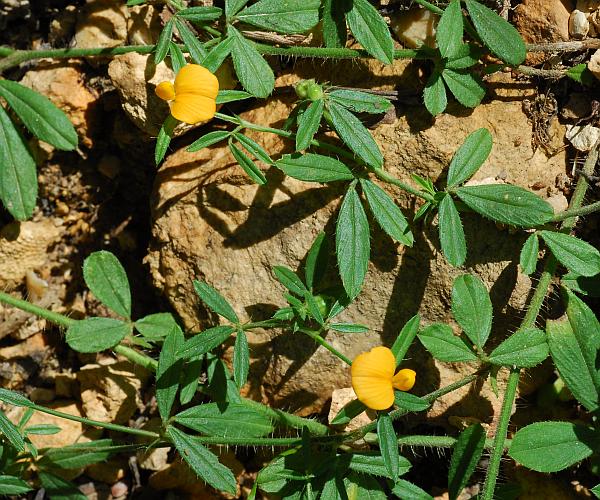Stylosanthes biflora (L.) Britton, Sterns & Poggenb.
Pencil Flower

Native
CC = 5
CW = 5
MOC = 68
© SRTurner
Stylosanthes biflora (L.) Britton, Sterns & Poggenb.Pencil Flower | |
 |
Native CC = 5 CW = 5 MOC = 68 |
© SRTurner |
|
Family - Fabaceae/Faboideae Habit - Perennial forb with a long, stout taproot below an often branched, woody caudex. Stems - Spreading to ascending, wiry, to 40 cm, usually well-branched, sometimes forming loose mats, glabrous or more commonly moderately to densely pubescent with fine, appressed-ascending hairs and often also stiff, bristly, spreading hairs. The erect trichomes are red when viewed with a lens.
Leaves - Alternate, petiolate, trifoliate, stipulate. Petioles with the free portion 1-3 mm long, the basal half fused to the stipules. Stipules fused to the petiole and into a sheath around the stem, this 4-7 mm long, hairy, the free portions 3-6 mm long, linear, bristly-hairy along the margins. Stipels absent. Leaflets 8-20 mm long, 3-7 mm wide, the terminal leaflet sometimes slightly larger than the lateral pair and with a stalk 1-2 mm long, narrowly elliptic to lanceolate, oblanceolate, angled at the base, angled or slightly tapered to a bluntly or sharply pointed tip, the midvein extended into a minute sharp point at the very tip, the margins entire, glabrous or sometimes sparsely bristly-hairy, the surfaces glabrous, the upward-angled lateral veins relatively prominent on the undersurface.
Inflorescence - Axillary and terminal, solitary flowers and/or short, dense spikelike clusters of 2 flowers, the stalk 4-8 mm long, hidden in the stipular sheath (the inflorescences thus appearing sessile or nearly so), the bracts 3-5 mm long, 1-3 mm wide, linear to narrowly lanceolate, sometimes 3-lobed, usually bristly-hairy; bractlets 2-3 mm long, linear. Flowers - Flowers sessile, but sometimes appearing short-stalked because of a hypanthium below the perianth, this 3-5 mm long, usually glabrous. Calyces with the tube 2-3 mm long, bell-shaped, glabrous, 2-lipped. Corollas papilionaceous, orangish yellow to yellow, often fading to whitish or pinkish, the banner 5-9 mm long, 4-7 mm wide, the expanded portion broadly obovate to nearly circular, rounded to more commonly slightly and broadly notched at the tip, slightly keeled longitudinally, bent upward abruptly toward the base, the wings 3.5-5.0 mm long, 2-3 mm wide, oblong-oblanceolate, rounded at the tips, somewhat cupped around the keel, the keel 3-5 mm long, 2-3 mm wide, boat-shaped, curved upward, bluntly pointed at the tip. Stamens 10, the filaments all fused into a tube 5-6 mm long, the free portions 2-3 mm long, curved, the anthers of two kinds, 5 of them oblong and attached toward the midpoint, alternating with 5 that are nearly globose and attached near the base, yellow to orange. Ovary 1-2 mm long, usually minutely hairy, the style 6-8 mm long, glabrous or minutely hairy, curved or curled, the stigma terminal, minute.
Fruits - Loments, 5-7 mm long, 2-3 mm wide, divided into 2 segments, the lower segment usually infertile, appearing stalklike, pale, and hairy, the upper segment 3.0-4.5 mm long, obliquely ovate in outline, flattened, tapered at the tip to a curved or curled beak 0.5-1.0 mm long, the outer wall papery, brownish yellow to brown, glabrous or minutely hairy, with a prominent network of rounded ridges, indehiscent, shed as a unit, 1-seeded. Seeds 2.0-2.5 mm long, broadly oblong-circular in outline, flattened, the surface yellowish brown to brown, with irregular, blunt ridges, somewhat shiny.
Flowering - June - September. Habitat - Glades, upland prairies, sand prairies, savannas, dry upland forests, tops of bluffs, streambanks, strip mines, old fields, and roadsides. Often on acid substrates. Origin - Native to the U.S. Lookalikes - None. Other info. - This little species can be found mainly in the southeastern 2/3 of Missouri. Elsewhere it occurs throughout the southeastern quadrant of the continental U.S. The plant is easy to ID in the field but is often overlooked because of its small size. The small, bright orange-yellow flowers, which often appear nearly circular, are unique in Missouri's flora. Photographs taken in the Croatan National Forest, NC., 7-17-02, and off Hwy 106, Shannon County, MO, 6-6-03 (DETenaglia); also at Little Lost Creek Conservation Area, Warren County, MO, 7-24-2016 and 7-8-2020, Millstream Gardens Conservation Area, Madison County, MO, 9-3-2020; and Schuette Prairie, Polk County, MO, 6-19-2024 (SRTurner). |